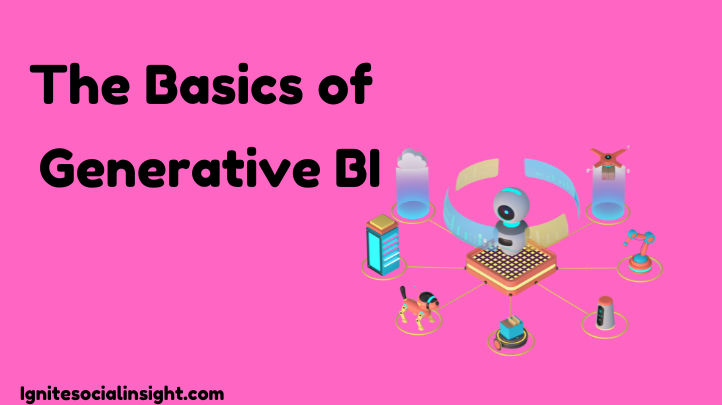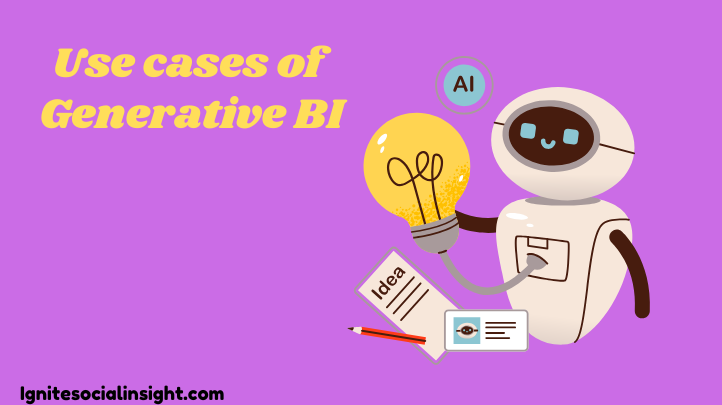
Generative AI is revolutionizing BI transforming business data into smarter and more practical solutions. Unlike traditional methods it does not analyze data. It creates tailored insights and solutions. It helps businesses find hidden patterns and predict results. They also let them make faster, better decisions.
For example it can turn sales data into a strategy. Or it can turn customer feedback into product improvements. Generative AI introduces automation, accuracy, and innovation into the realm of business intelligence. It lets teams focus on strategy not data crunching by reducing manual work. It revolutionizes how organizations stay competitive in today data driven landscape.

Generative Business Intelligence uses advanced AI. It turns raw data into useful insights. Unlike traditional Business Intelligence tools users must interpret their charts and reports. Generative AI is revolutionizing Business Intelligence analyzes data and suggests actions. It is a smart assistant for decision-making. The key parts of generative Business Intelligence include:
I remember working with a small retailer struggling to understand their sales data. Their old Business Intelligence system showed them graphs but they did not know why sales dipped on certain days. By using generative Business Intelligence the AI identified that weather changes affected sales. It even suggested stocking up on rain gear during the rainy season.
Generative Business Intelligence is different from traditional Business Intelligence because it does not just show data it explains and acts on it. Traditional Business Intelligence feels like a map. Generative Business Intelligence feels like a GPS with turn by turn directions.
Big data is like a vast puzzle. Generative Business Intelligence helps assemble the pieces. It simplifies complex data by spotting patterns and providing clear insights. Businesses often deal with data from many sources like sales and social media. They also get it from customer feedback. Generative Business Intelligence combines all this information to tell a complete story.
For example I once worked with a company that managed thousands of online orders daily. Their challenge was finding trends in this huge dataset. Generative Business Intelligence not only organized the data but also found buying patterns. Customers bought more in the evenings. It predicted which products would sell best during the holidays. This helped the company plan better.
Generative AI is revolutionizing BI and also works with big data platforms like Hadoop and Spark. It is a powerful tool for industries like healthcare and finance. It helps businesses analyze huge amounts of data faster and more effectively.
Generative Business Intelligence goes beyond basic reports to find hidden trends and patterns. It can uncover customer behavior market shifts and hidden opportunities. Users must personalize Business Intelligence dashboards. They ensure users get the needed insights. The Economics of Coding Education highlights how modern technology can transform industries, just as Generative Business Intelligence
I recall helping a financial firm. They wanted to know why some clients left while others stayed loyal. With generative Business Intelligence we analyzed customer feedback and account activity. The AI found that clients were unhappy with long response times. By addressing this issue the firm improved retention rates by 30%.
In retail generative Business Intelligence can analyze purchase history. It can then suggest products customers are likely to buy next. In healthcare it helps predict patient needs by analyzing medical records and trends. These insights drive more informed decisions and improved results across various industries.

Generative AI is revolutionizing BI and has changed how businesses solve problems. It automates tasks predicts customer behavior and speeds up supply chains.
Although generative AI is revolutionizing BI is powerful there are challenges to ensuring its smooth operation.
Using generative Business Intelligence comes with responsibilities.
Generative AI is revolutionizing BI as the future of smart decision making.
Generative AI is changing how businesses use data. They make decisions faster, smarter, and more effectively. It is not about crunching numbers. It is about finding hidden opportunities and giving companies an edge. The potential of generative AI in Business Intelligence is enormous, and they have only scratched the surface of what it can do.
During a project, I saw how generative AI transformed a struggling retail business. The client had piles of data but did not know how to use it. Using AI-driven Business Intelligence tools they found new patterns. They were unique customer preferences and seasonal trends. Seeing how these insights drove better decisions and real growth was incredible.
Adopting generative AI is not without challenges. Businesses must address ethical issues such as data privacy and fairness and ensure that AI provides equal benefits to everyone. Technical hurdles such as integrating AI into older systems also need attention. But with proper planning and training, we can overcome these challenges. A commitment to transparency is key.
It is clear that generative AI is revolutionizing BI and will shape the future of data driven decisions. Companies using it now will be ready for a future where smart systems give ideas and insights. The journey may not always be easy but the rewards are worth it.